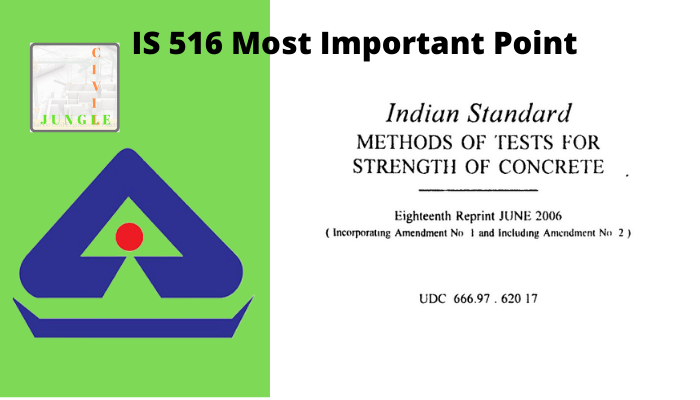Is PDF Download: Click Here (Credit : www. iitk.ac.in)
As Per Is 516: 1959 Sampling of Material In Lab
A representative sample of the materials of concrete, as per the cube testing IS code, for use in the particular concrete construction work shall be obtained by careful sampling.
Test samples of cement shall be made up of a small portion taken from each of a number of the bag on the site test samples of aggregate shall be taken from a larger lot by quartering.
As Per Is 516 Cl 2.6.1: Machine Mixing For Cube In Lab
As per the IS 516 code, the period of mixing shall be not less than 2 minutes after all the materials are in the drum, and shall continue till the resulting concrete is uniform in appearance.
When using pan mixers, the concrete shall be heaped together before sampling.
As Per Is 516 Cl 2.6.2: Hand Mixing Procedure For Cube In Lab
- The cement and fine aggregate shall be mixed dry until the mixture is thoroughly blended and is uniform in colour.
- The coarse aggregate shall then be added and mixed with the cement and fine aggregate until the coarse aggregate is uniformly distributed throughout the batch, and
- The water shall then be added, and the entire batch mixed until the concrete appears to be homogeneous and has the desired consistency.
- If repeated mixing is necessary, because of the addition of water in increments while adjusting the consistency, the batch shall be discarded and a fresh batch made without interrupting the mixing to make trial consistency tests.
- Mixers, the concrete shall be heaped together before sampling.
Also, read: What Is Camber in Road | Types of Camber | Advantages of Camber in Road
As Per Is 516 Cl 2.9.3: Tamping Bars / Road For Cube
The tamping bar shall be a steel bar 16 mm in diameter, 0·6 m long, and bullet-pointed at the lower end.
As Per Is 516 Cl 2.10.1: Cube Compacting dy Hand
Concrete Cube: For cubical specimens, in no case shall the concrete be subjected to less than 35 strokes per layer for 15 cm cubes or 25 strokes per layer for 10 cm cubes.
As Per Is 516 Cl 2.12.1: Cube Curing In Lab
The test specimen- shall be stored in a place, free from vibration, in the moist air of at least 90 percent relative humidity and at a temperature of 27° ± 2°C for 24 hours ± 0.5 hours from the time of addition of water to the dry ingredients.
After this period, the specimens shall be marked and removed from the molds and, unless required for a test within 24 hours, immediately submerged in the clean, fresh-water, or saturated lime solution and kept there until taken out just prior to test.
The water or solution in which the specimens are submerged shall be renewed every seven days and shall be maintained at a temperature of 27° ± 2°C. The specimens shall not be allowed to become dry at any time until they have been tested.
Also, read: Carbon Steel vs. Stainless Steel | What Is Carbon Steel | What Is Stainless Steel
As Per Is 516 Cl 3.3: Cube Curing In Filed
The test specimens shall be stored on the site at a place free from vibration, under damp matting, sacks, or other similar material for 24 hours ± 0.5 hours from the time of adding the water to the other ingredients.
The temperature of the place of storage shall be within the range of 22° to 32°C. After the period of 24 hours, they shall be marked for later identification, removed from the molds and unless required for testing within 24 hours, stored in clean water at a temperature of 24° to 30°C until they are transported to the testing laboratory.
They shall be sent to the testing laboratory well packed in damp sand, damp sacks, or other suitable material so as to arrive there in a damp condition not less than 24 hours before the time of the test.
On arrival at the testing laboratory, the specimens shall be stored in water at a temperature of 27° ± 2°C until the time of the test.
Records of the daily maximum and minimum temperature shall be kept both during the period of the specimens remain on the site and in the laboratory
As Per Is 516 Cl 5.6./ 6.6: Report For Concrete Cube
As per Is code 516 below report
- Identification Mark
- Date of test
- Age of specimen
- Curing Condition including date of manufacture of a specimen in the field,
- Weight of specimen,
- Dimensions of a specimen,
- Cross.Sectional area,
- Maximum load,
- Compressive strength, and
- The appearance of a fractured face of concrete and type of fracture if these are unusual
Cube Test Is Code
Compressive Strength of Concrete by Compression Testing Machine as per IS 516 part 1 and IS: 516– 1959.
Compressive Strength of Concrete Is Code
The IS code for the compressive strength of concrete in India is IS 456:2000.
Compressive Strength Is Code
The compressive strength test of cement is a standard laboratory procedure used to determine the compressive strength of cement. This test involves applying a compressive load to a cement cube or cylinder until it fails.
Cube Strength Is Code
For the cube test of concrete as per IS code, maximum load is applied gradually at the rate of 140 kg/cm² per minute till the specimens fails Load at the failure divided by cross-sectional area of specimen gives the compressive strength of the concrete cube.
Cube Sampling Is Code
The IS code for cube test and cube sampling of concrete in India is IS 516:1959. This code outlines the procedure for making and curing concrete test cubes and conducting compression tests to determine the compressive strength of concrete.
Cube Test Procedure as Per Is Code
Place the specimen in the machine in such a manner that the load shall be applied to the opposite sides of the cube cast. Align the specimen centrally on the base plate of the machine. Rotate the movable portion gently by hand so that it touches the top surface of the specimen.
What Is 516?
Area codes 516 and 363 are telephone overlay area codes in the North American Numbering Plan for the U.S. state of New York. The numbering plan area comprises Nassau County on Long Island. Area code was created in 1951, and 363 was added to the numbering plan area in 2023.
Is Code for Concrete Cube Casting?
cube casting process at site as per IS Code 456-2000.
Code for Compressive Strength of Concrete
For that, you need to refer to IS 516: 1959 – Methods of test for the strength of concrete which covers tests for the determination of the following properties of cement concrete. One delimiting factor in determining the compressive strength of concrete is that concrete requires 28 days to reach the hardened state.
Compressive Strength Test Is Code
IS 516: 1959
For that, you need to refer to IS 516: 1959 – Methods of test for the strength of concrete which covers tests for the determination of the following properties of cement concrete. One delimiting factor in determining the compressive strength of concrete is that concrete requires 28 days to reach the hardened state.
Concrete Slump Test Is Code
The IS code for the concrete slump test in India is IS 1199:1959. This code defines the method for determining the consistency or workability of freshly mixed concrete using the slump test. The slump test measures the vertical settlement of a cone-shaped concrete sample when the cone is removed. This provides an indication of the concrete’s workability and can help assess its quality for specific applications.
Like this post? Share it with your friends!
Suggested Read –
- Plate Load Test
- Consistency Test
- Define Workability
- Live Load Vs Dead Load | What Is Load in Civil
- Difference Between Carpet Area and Built-up Area
- Difference Between One Way Slab and Two Way Slab | What is Slab
- What Is a Field Dry Density Test | Different Type of Field Density Tests
- What Is Plaster | Plaster Ratio | History of Plastering | Requirements of Good Plaster
- What Is Glass Fiber Reinforced Gypsum | Applications of GFRG | Disadvantages of The GFRG Panel


Leave a Reply